Most of us Ford fans have a shelf full of books on Shelbys and Cobras, but rarely do we hear how these books came about, what actually inspired them to be written in the first place. In this case, we were able to hear straight from the horse’s mouth–from the author of 18 books overall, several of which were on Shelby, Cobras, GT40s, etc. The author, octogenarian Wallace Wyss, volunteered to tell us about his many decades of involvement in recording Shelby history.
Mike Gulett, Editor
Q. When did you first see a Cobra?
Wyss: It was around 1963, I was in my hometown, Detroit, and a Woodward Ave. cruiser, and used to see a white Cobra, maybe it was a 260, being driven by a guy who later started one of the first Toyota dealerships (Royal Toyota). I knew I could never catch the car but I knew it must be pretty special. Of course at the time I had barely heard of Shelby.
Q. When did you meet up with the Cobra again?
Wyss: It was in the summer of ’65, I had driven out to California with my twin brother, both of us looking for summer jobs and I walked into Motor Trend just when they had fired everybody but the editor. So for a couple months, while still a teenager, I was a Motor Trend associate editor. One of the first assignments was to go out to Shelby’s LAX airport factory and see the 427 Cobra. The PR man offered me one to test drive but my editor, Mike Lamm, thought it would be too much for me!
Q. Did you meet Shelby at that time?
Wyss: He must have been off in Europe with the Ford GT40 team. That was the year they first ran the 427 Mk. II versions but failed to win, the year that Henry Ford II issued the terse order for 66: “win or else”.
Q. When did you first meet Shelby?
Wyss: I don’t know the year but the meeting came off in a dramatic way. I was back in Detroit, walking along a street during lunch hour and I heard a roar and saw a red 427 Cobra drift around a corner, a Comp car with open pipes and great balls of fire were coming out the side exhausts which caused a horse being ridden by a policeman to buck in panic. A diminutive woman was at the wheel. She pulled up next to me, pointed directly at me and demanded’ “You–which way is Cobo Hall?”
I said “If you give me a ride I’ll show you” and she accepted and leaned over and opened the passenger door. I strapped myself in and she drove off at full speed. I had to shout to her she had gone North on the Lodge freeway instead of South so she took an exit, headed South and in a minute we were at Cobo Hall. As I got out of the car she introduced me to Shelby who immediately palmed me off on Phil Remington, his ace mechanic and I got to ask a couple of questions.
Q. So when did you write that first book about Shelby?
Wyss: That was “Shelby’s Wildlife: the Mustangs and the Cobras”. That came about when, about ten years after college, I was not in advertising anymore, and out on the West Coast and a Ferrari fan so I called Motorbooks and asked them if they wanted a Ferrari book and Tom Warth, the founder of that company, replied “There’s too many books on Ferraris, what about doing one on the Cobra?” Well, I told him “No” because I didn’t want to do books on American cars. Then about two days later I thought, well, hell, I’m not doing anything and so I called him back and agreed. All the information I had on Cobras was a little pamphlet sized Cobra club roster from a club in Grosse Pointe, Michigan, that a car lot employee had given me. It gave the SN of the cars in their club and a little resume of each car’s history.
Q. Did you have any help on the book?
Wyss: I was able to go interview Shelby twice. I had already gone out on a photography expedition with him when I had met a guy with a 427 Cobra and talked him into driving out to Shelby’s office in Playa Del Rey, CA and going with us to a beachside location where we could photograph the car with Shelby for Auto Motor und Sport, a German magazine. Shelby’s attitude at the time was “I can’t believe people actually care about this old car that I stopped building years ago.”
Once I got the book assignment, mostly I went back through the old magazines, and visited with former Shelby employees. Some of them had gone from working on the fastest cars in the world in 1965 to being say, a mechanic on school buses. Anyhow ironically a Shelby club helped me at first, proofreading the manuscript, but then midway, tried to make their own deal with the publisher and ended up with a small percentage of my book’s royalty. Then for decades, they derided the very same book that they themselves had worked on and were being paid a percentage of! The book stayed in print for 17 years but eventually was made obsolete by changes in Shelby’s life (i.e. going to Chrysler) and many new books coming out, some from the same Shelby club.
Q. Wasn’t there a Shelby’s Wildlife race car?
Wyss: Not owned by me, unfortunately. A racer from Santa Monica ran his Shelby GT350R with my book’s title on it for only two events but was embarrassed to look like his was a sponsored car for some reason and took the signs off. Then he eventually smashed it up pretty spectacularly mid-race when a wheel fell off.
Q. And wasn’t there a version of your book with the Chrysler Dodges?
Wyss: There was one of my Shelby books that included them but I regret now we ever included the Dodges. That part of the story is only interesting because it showed how Shelby could still develop fast cars even in a front drive world.
Q. And then what about the picture books?
Wyss: Yes, there were two different photo albums. That’s what they were called. One was on GT40s, done when I met Brian Winer, who is a big Ford GT fan and we did that one together using his archive, and then later I did one on Shelby Mustangs and Cobras, which had some of my pictures and old file pictures, some of which I had saved from when Shelby’s PR man handed them to me in 1965. I also worked in Detroit in the ’70s and often would visit Paul Preuss, a PR man, who would go to lunch and then prior to leaving, say “I’m going to lunch but you can have any picture you find” and naturally I would go to the Shelby/GT40 drawer.
Q. Before you started on the “SHELBY: The Man, the Cars the Legend”, didn’t you worry about competition?
Wyss: I was worried that, unlike when Shelbys Wildlife hit the market decades earlier, there were several new books on Shelby out and some more being written but the upcoming one I was most worried about was due to be coming from someone I knew, Eric Davison, who I worked with in Detroit when I was a copywriter on the Oldsmobile ad account decades earlier told me he was doing a Shelby bio. Much later on, he had moved to Los Angeles and at least once I worked free lance as a copywriter for the agency he was with out here. When he told me he was working on a book about Shelby, I thought “I’m screwed” because of course at the time, being Shelby’s PR man on the Olds powered Series I, he had current access to Shelby.
So before I wrote my own Shelby book, I kept asking him “Why don’t you broaden your book out to cover all of Shelby’s business history?” and then sweated that he would say “Yes” but eventually on his own he announced that he was going to narrow down the subject of his book to one chapter of Shelby’s life, saying “I worked on the Series 1 and that’s what I know” so he stuck to that and came out with a damn fine book that really nailed that perilous part of Shelbys history (when he lost half his fortune). But that episode is only a fraction of Shelby’s entire business history so once he announced his new focus, I figured “If Eric isn’t going to do the general business history, I’ll go ahead and do it myself.”
Q: Did “SHELBY: The Man. The Cars. The Legend” have a race-by-race history?
Wyss: No, the Cobras’ racing history, both roadsters and coupes, is covered in brief, and the GT40 program as well but it’s all kept general, because there already were plenty of coffee table-like books that went into the history of each and every car serial number-wise and recount what happened to each car at each race. I was determined to focus on the big picture–why Ford sponsored Shelby, why Ford thought winning at LeMans was so crucial, etc.
Q: So by “big picture” you mean no nuts-and-bolts?
Wyss: Oh, there’s nuts and bolts but something had happened between the time I wrote Shelby’s Wildlife, back in 1977, and the new book and that was the spread of the internet. I figure that with the advent of the internet, it’s no longer necessary to go into what the cfm was of the ’65 Shelby GT350 carburetor because anyone who wants to know a technical fact like that can go to a search engine and find that in five seconds. I spent my time trying to find out why Ford did this or Olds did that in respect to Shelby, which gives the reader a broader view than just discussing the hardware.
Q: What made you think of this approach?
Wyss: Well, I knew about that approach but just had never written in that style. I first came across that style in ’65, while visiting a bookstore in Hollywood. There I happened to meet Tom Wolfe, the author who was hawking his book of short pieces one of which was about custom cars the book title was “The Candy-Colored Tangerine Flake Streamllne Baby”. I asked him to lunch in a cafe on the Sunset strip. He taught me that people want a good story. When he wrote about the astronauts in a later book, you notice he doesn’t go into nuts and bolts of the aircraft they flew before they became an astronaut, etc. but instead tells a good story, which incidentally made a good movie. So when Tom Warth, who had sold Motorbooks and started a firm called Iconografix, said my brief in writing a new Shelby book would be: “You can write it how you want” then I thought OK I’ll do it as if Wolfe was writing it, tell it in one long narrative tale, and not bother with spring rates, carburetor CFMs and all that. Kind of like you’d hear at a bar in Jackson Hole, Wyoming when you and your car racing buddies are well past the third drink.
Q: Did you have any other inspiration?
Wyss: Well, it’s hard to believe but I can blame a picture of Ralph Lauren in his 1957 Ferrari Testa Rossa as another inspiration. That’s because ol’ Ralph Lauren, founder of Polo brand clothes, was pictured toodling along in his $5 million Ferrari wearing a leather jacket, like an old WWII flying jacket, and a billed baseball cap and I thought “That’s cool–driving a car so fast and powerful and valuable but dressed like he’s going out to walk his dog. I know Cobra people who look like that–driving powerful Cobras but dressed casually, unlike Ferrari owners who are always trying to impress you with their Gucci-Pucci clothes and expensive chronometric watches and so forth.” So I partly did the book to try to capture that spirit of the Cobra owners and spend a few paragraphs trying to describe the feeling that comes from driving around in a Cobra.
Q. What about other things not covered in other Shelby and Cobra books up to that point?
Wyss: There were many new books on Cobra and Shelby at the time but not many yet that discussed Shelby’s own race driving career. I like to feel that Shelby’s hard charging style as a race driver was reflected in his hard charging style as a businessman so it was a natural approach to me to take a couple of chapters to educate the newcomers to the fact that, back in the mid-‘50s, Shelby was in fact one of America’s most promising sports car drivers–at a time when race driving was still damn dangerous. And the remarkable fact is that when Phil Hill was already a professional sports car racer, Shelby was still a chicken farmer down in Texas. The fact he came out of nowhere and won LeMans only five years after he first began making money as a driver is really worth talking about. The amazing thing is that during his whole driving career, he had a bad heart and popped nitroglycerin pills like candy. He hid his illness with fake doctor reports until one day, mid- race, after popping the fifth or six pill, he decided to quit racing and pulled into the pits for good.
Q: This time around, did you talk to many Shelby employees?
Wyss: Off and on. In fact, you could say this is a story I’ve been working continuously for forty or fifty years, ever since that day in Detroit when that pert young lady (Pat Merone) pulled up next to me in a 427 Cobra asking directions. So, in the intervening decades, I’ve talked to many former employees. With the new book assignment, I went back to visit a selected few, including Phil Remington who worked at Dan Gurney’s shop right to the end and Charlie Agaipou, who was a wrench for Shelby, who runs a Rolls and Bentley shop in West Hollywood. Also forty years ago when I researched the first book, Al Gore hadn’t yet invented the internet so I couldn’t reach people I was trying to find. Now in a few minutes, I can contact former race car designers and racers throughout the world to clarify different small points like why the suspension was unsatisfactory on the Len Terry-designed King Cobra.
Q. How much content was there in “Shelby: the Man, the Cars, the Legend” on the post-2000 Shelby Mustangs?
Wyss: Quite a bit. In the first book, I go into how Shelby was asked by Iacocca to build the Shelby Mustang and it is interesting to me how reluctant he was at first, saying something derogatory about the wishy-washy handling, and then later on I have another whole chapter on Trans-Am racing. Then in later books I talk about Shelby’s re-hiring as a spear carrier by Ford to market the ’07 Shelby Mustang.
Q. Did you learn anything in your new research that you didn’t know before?
Wyss: I always learn! I didn’t realize until I read Dave Friedman’s book on Remembering the Shelby Years how much Holman & Moody, the stock car race car builders, were always trying to rip off a piece of Shelby’s business, and I think, if Shelby hadn’t accepted the assignment to do the Shelby Mustang, it would have been a Holman & Moody Mustang produced car instead. (Holman & Moody had already built over 100 Ford Thunderbolts, so were used to making small limited edition runs). Also I think few Americans are aware that some of the first Mustangs ever built were sent to Alan Mann over in England for preparation as rally cars so Mustangs were already racing in Europe at a time when the decision had already been made in Dearborn to market the car in America as a “secretary’s special.”
Q: And on subsequent books, you went into Shelby’s later business ventures?
Wyss: Yes, this book goes well beyond Shelby-American. It recounts Shelby’s Tiger involvement, his working with Iacocca on the front wheel drive Dodges and the Viper, then the ill-fated Olds-powered Series 1, and ends with the new deal with Ford, which, by the way, still continues to today.
Q: Weren’t you taking a chance by covering non-Ford related Shelbys, in that Shelby’s fans seem to orientated toward those with Ford power?
Wyss: Not really, I followed him in his journey from one automaker to another, for better or for worse.
Q: How do you come down on the Cobra replicas?
Wyss: In one book I have a whole chapter on that non-stop knock-down drag-out battle that continued for something like 30 years. I tell how initially Shelby was opposed to all replicas of his cars but then recount how it was that he gradually came around to entering the replica field himself though at first he called the ones he was making “continuation cars” as if he was continuing to build cars that had already been started. It’s too bad I couldn’t get the old CAR magazines from England so I could have included his written blasts at the British car builder, Brian Angliss, for reviving the Cobra and selling it through American Ford dealers as the Mk. IV, without Shelby’s involvement. He even sued a replica builder in the U.S. and lost, eventually realizing he hadn’t done enough to secure the design, which was really an evolution of the A.C. Ace from the 1950s. He eventually decided if he couldn’t beat the replica builders, he’d compete against them.
Q: What about artwork?
Wyss: There is artwork in the form of black and white historical photos. This is primarily a words book, as opposed to what I call a “coffee table” tome like Randy Leffingwell’s beautiful (and heavy) book, also entitled “Shelby” (published by MBI) which I would characterize as primarily a “pictures-with-words” book.
Q: Who did you see as your market?
Wyss: Well, back in 2007, my thought was that, with over 10,000 people scheduled to buy the new GT500 Shelby Mustang and who knows how many buying the ’07 Shelby GT Mustang and even those buying the GT/CS Mustang, there’s going to be a whole lot of newbies entering the Shelby world in 2007 and not all of them have been involved in the marque for 40 years like myself, so many will be clueless about such terms as “FIA cars” or “USRRC cars” or “cut-back fenders.” At the beginning stages of a newcomer’s interest in the man and his cars, I figured they want to know basics, like “Why did Shelby become involved with Dodge?” and so forth.
With the newcomer to the marque in view, we kept the cost down by going softbound and pricing it at $19.95, so it could be the ideal bargain book for Shelby fans to give to their buddies to get them up to speed on Shelby so they can later dive into the subject deeper and buy the single marque books that list all those nitty gritty details of each Shelby model.
Q: Did you have any help from Shelby or Ford?
Wyss: Of course many auto historians, once they get an assignment and are no longer writing the book on spec, go straight to the subject’s PR firm and say “What can you give me?” and I did that at first but stopped asking when it looked like they expected me to submit the work for approval prior to publication. I didn’t want to have a PR man looking over my shoulder and saying ‘Oh, God, don’t put that in’, because it’s my feeling that no real historian would go for that arrangement. If he or she does, that journalist might just as well trade in their JOURNALIST badge for that of a PR man. I enjoyed an ongoing relationship with Ford PR but they never saw more than a handful of pages and those only on the reintroduction of Shelby models.
Q. Didn’t you do a later edition of “Shelby: The Man, The Cars, The Legend”?
Wyss: We did. There’s a second edition with more pictures, and also, just for fun, a quiz with 50 questions that I daresay most Cobra fans, even those with a shelf full of books on everything Shelby, could not answer right all 50 correctly from the get-go.
Q. Now wasn’t there an official biography of Shelby done before he died?
Wyss: There was a huge hardbound door-stopper, maybe the first edition was about 3” thick and then there was a later cut-down version, both by a British writer named Rinsey Mills who ironically had written articles beforehand that implied that Shelby had just modified a car that already existed and that the Cobra was not so great an achievement. The big biography he subsequently wrote was officially sanctioned, approved by Shelby, who wrote the introduction (as he had done on Shelby’s Wildlife) but I had a hard time reading through Mills’ book because of all the extraneous information. Like if Shelby would say “Africa” Mills would throw in 10 pages on the history of Africa before he got back around to Shelby. But I enjoyed the story in there about Shelby’s wife flying in from Texas back in the early ‘60s, demanding to confront Shelby’s live-in girlfriend, a movie star he later briefly married after his divorce. And then one of my favorites, can’t remember if he had this or not, but it’s in my book–is when Shelby’s nose was cut off in a Maserati crash at Riverside and his girlfriend fainted when she saw his schnozz sitting next to him on a table before they sewed it back on…
Q. Would you change “SHELBY The Man, the Cars the Legend” if there was a new edition?
Wyss: Well, I can see now, in light of subsequent events, I’d have to re-think my position on the continuation cars, the exact copies of 427s he made, because now Jaguar has up and said something to the effect of “Oh, we never finished our build-out of D-Types so we’ll go back and build a few more” and then followed that with a batch of lightweight E-types, and the classic car establishment didn’t condemn them outright. To me this is messin’ with history big-time, an automaker going back and making some oldies but goodies. So soon Mercedes will probably decide to make more 1954 all-alloy bodied gullwings, Porsche could just as easily make a few more ’57 Carrera speedsters and the result will be wholesale confusion in the auction world. So what I criticized Shelby for in my last book, when he first said he found some uncompleted 427 Cobra chassis and intended to complete them (making between 11 and 13, accounts differ), is now accepted. But not by me. I am more of a “strict constructionist,” for instance if a P51 Mustang rolled out of the factory door the day after VJ Day, to me it’s not referred to as a “WWII airplane” but a “WWII-era” plane.
Q. Wasn’t there some talk of a movie being made of your Shelby biography?
Wyss: In 2011, a Hollywood producer bought an option to buy the film rights to “SHELBY: The Man. The Cars. The Legend” at a set price and make a TV series. But then they decided to go ahead with another series instead, one about if the Germans had won WWII. So in the end they never bought my book’s film rights only optioned it. Anybody’s interested in optioning any of my Shelby books, they can write me at Photojournalistpro2@gmail.com. I still think it would be an exciting TV series or feature and I’d cast Matthew McConaughey as the lead as he’s from Texas, so you know he has that twang down pat and also he’s tall enough to boot!
Q. And now you do paintings of Cobras?
Wyss: And GT40s. Funny thing, I don’t have an art degree, so the fine artists call me a “primitive” because that’s what you call untrained artists. But one of my paintings was bought by a prominent car Museum in Oxnard, CA so I figure, what the hey, that’s not bad when I’m still learning on the job. If anybody is interested in canvas prints of my paintings, they can write me at the same e-mail.
Q. Are your Shelby-related books still available?
Wyss: Only on Ebay or Offer Up and similar venues (all used books). Only Ford GT40 and the New Ford GT, the book I self published with Brian Winer and Al Axelrod, is still available new. GT40 fans can write me at the same e-mail I already mentioned and I will autograph it if they buy it.
Q. What’s your normal day like?
Wyss: I am still involved with a ranch life style like Shelby once had, going out to a ranch where I work with a friend’s thoroughbred horses. Then I come back home and work on portraits ordered by car collectors of their favorite car. At the end of the day I like to hang out in an outdoor cafe in the village of Claremont, CA drinking coffee and soaking up the village atmosphere. If I’m lucky, I’ll see a Cobra roll by…
Q. Thank you.
Let us know what you think in the Comments.
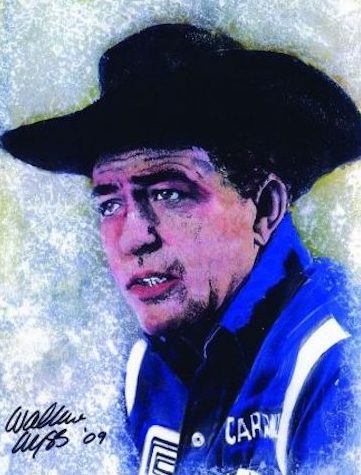
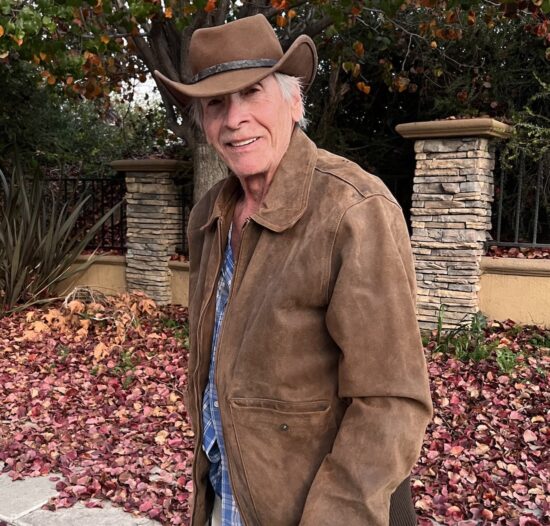
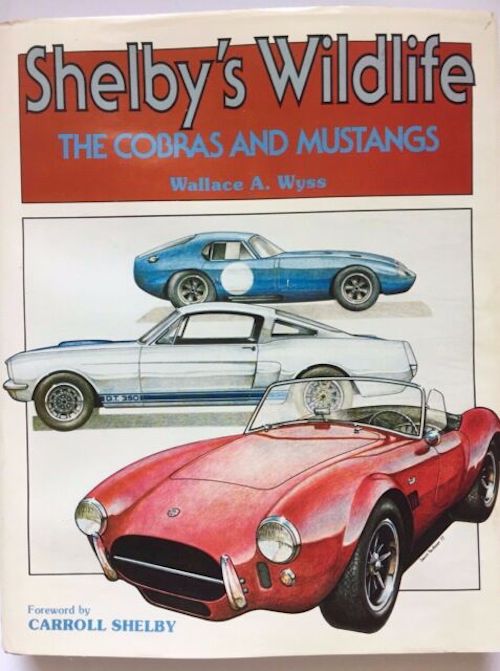
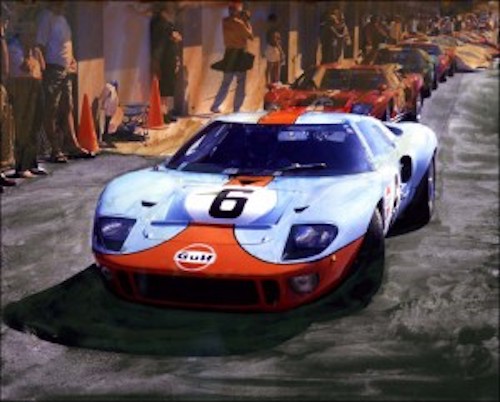
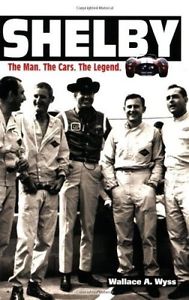
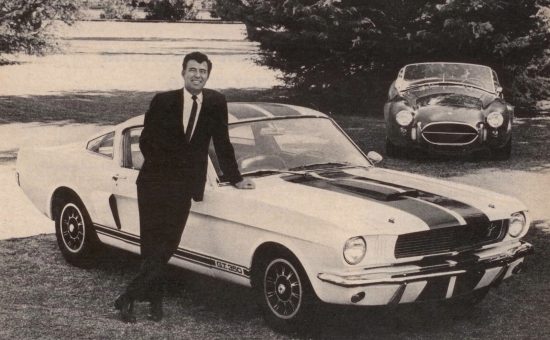
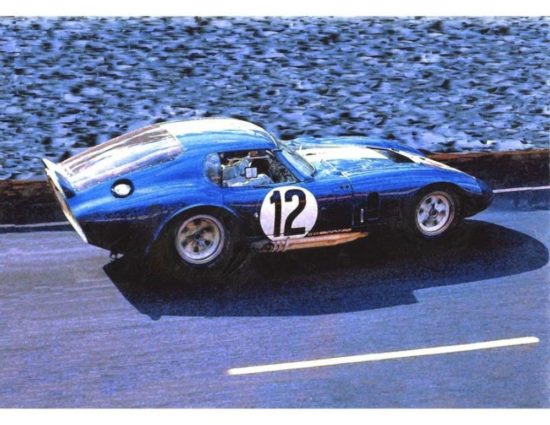
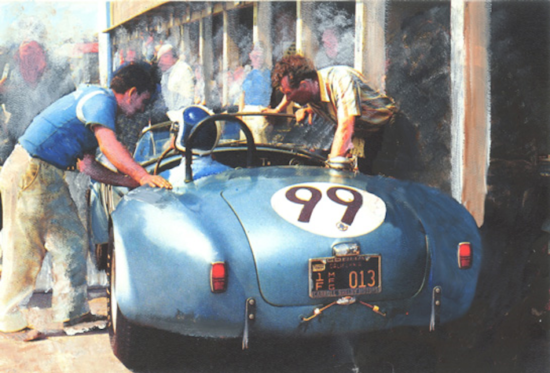
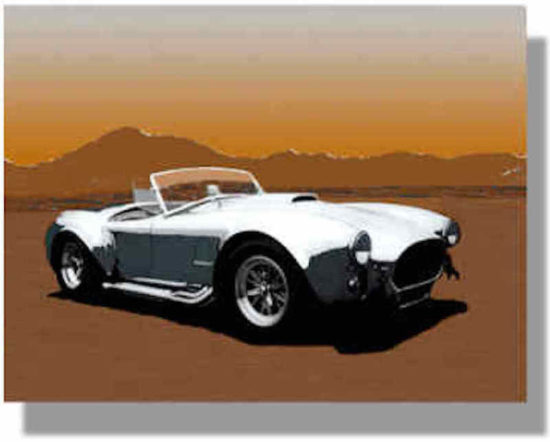
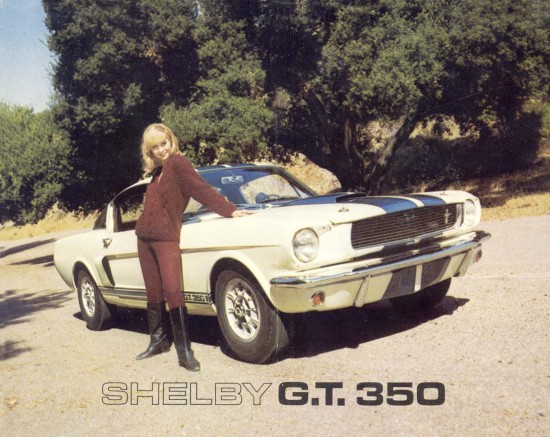
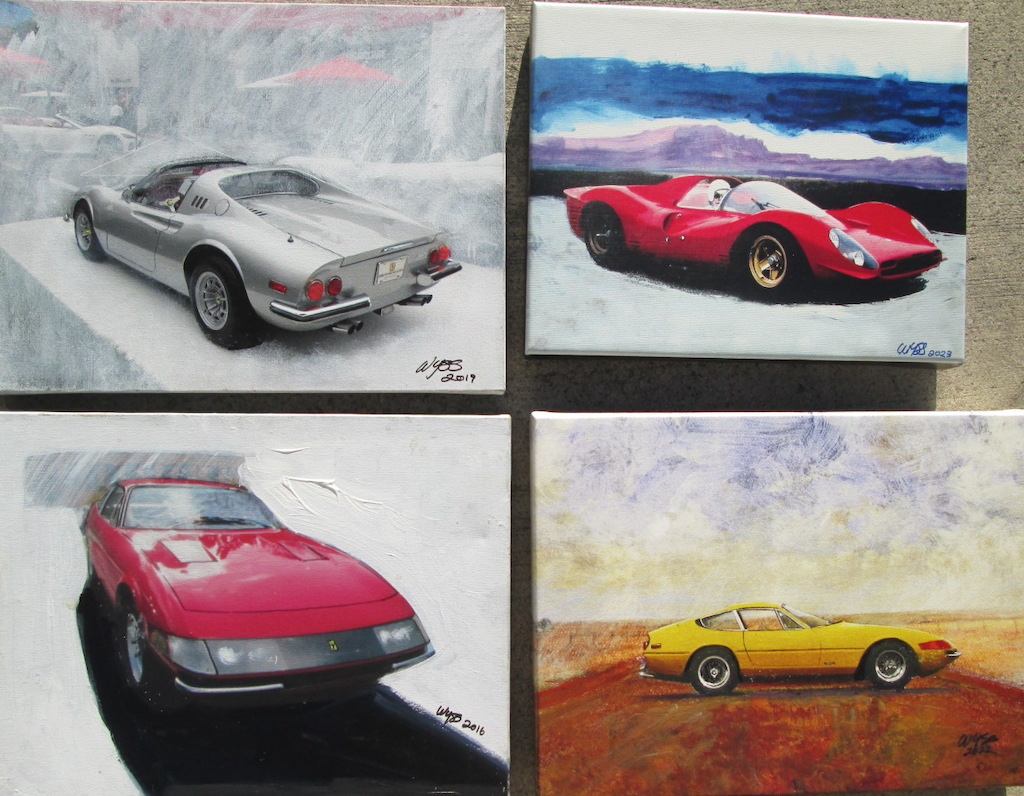

Wallace has really been such a remarkable backbone to this site. I very much appreciate all of the articles, personal anecdotes, photographs and maybe most of all his fine artwork. I have never met the man, but I feel I know him after reading and viewing so much of his dedicated material.
Wallace, thank you kindly for your contribution to my enjoyment of this car hobby for so many fantastic years. I’m sure there are thousands out there that feel the same way. Oh, and btw, that thing about not being considered a ‘Fine Artist’ for lack of a formal art degree?? That’s like saying that John, Paul, George and Ringo were are not considered ‘Fine Artists’ because they didn’t attend a music conservatory! From my perch I view your artwork as quite brilliant, and best of all it’s uniquely consistent–distinguishable as yours–Just like when we gaze at Jeff Stephan’s work under either clamshell of Lamborghini Miura, or when we hear a guitar lead by Steve Lukather or Eddie Van Halen, amazingly, through only the voice of an instrument, tool or brush, we all know whose artwork we are absorbing into our fortunate souls.
Cheers, Merry Christmas and thank you again, Wallace!
Best,
Bill Rice
Ps–Loved the hat tip to Al Gore. Ha!
A great and entertaining article Wallace. I love the historic tidbits on Shelby and your interactions and experiences. Thank you.
Was at Pebble Beach 2011 Met Carroll Shelby while he was gathered with Cobras, and friends and associates. What a wonderful experience.
Pebble beach 2011
Shelby photos
That looks like Edsel Ford (third from the right).
Technically it’s Laguna Seca racetrack where vintage races take place the time around Monterey Car Week. Who are some of the others? Maybe the guy on far left is Lynn Park, a Cobra enthusiast who owns at least ten real ones, as well as (oh, the horror), an electric one) He has raced in vintage events with his two sons, all driving some of the family’s Cobras,
Back in 1971 or 72 I was at my late friend Joe Sheppard’s repair shop in Tampa. Joe and I were working together on my 64 Tiger that I bought from him in pieces. Just before Joe left for lunch (he always left to have it with his wife ) the phone rang. After talking way past his normal time to leave I asked him who was that ? Carrol Shelby ! I almost fell off the stool I was sitting on. Turned out there was a street GT40 in Tampa that would not run correctly. A few days later I watched a light blue metallic GT arrive on a trailer behind a ford station wagon. Joe disassembled the multiple Weber carb’s over a few days and the car disappeared never to be seen again. Joe was a master at setting up SU’s and Webers. How did Shelby pick Joe to do the repairs ? Shelby American used his shop as a preparation area leading up to Sebring in 1964/65.